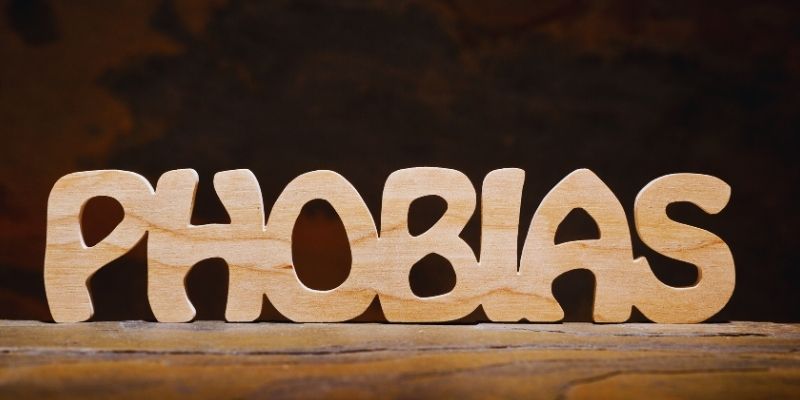Many people link phobias with heights or spiders, but many go beyond popular concerns. Some people get anxious over topics that most people would regard as either benign or funny. These strange phobias can be just as genuine and crippling. Phobias, including the dread of mirrors, bananas, or even long words, may seem absurd. For those who go through them, they are upsetting, though. Mental health professionals classify such responses as curable but irrational.
Every one of these strange phobias helps clarify the human brain's actual complexity. Knowledge about unusual phobias helps to lower stigma and raise awareness. It encourages us to show empathy for the challenges of others. Find out how unusual phobias arise and influence daily life in unanticipated ways.

Spectrophobia – Fear of Mirrors
The strong dread of mirrors or one's reflection is known as spectrophobia. It transcends just unpleasantness. Those who have this phobia could worry about what they would find in mirrors or believe they have magical abilities. Many times, horror movies and folklore aggravate these anxieties. Mirrors start to represent terrible omens or secret peril. Some patients believe mirrors reveal spirits or trap energy. They completely avoid mirrors, both at home and in public places.
Usually starting in childhood, the terror gets greater with time. Therapy helps, but many still battle silently. People with spectrophobia could feel alone when others write off their anxiety. Support begins with understanding this unusual condition. Unusual, irrational fear disorders like spectrophobia call for sympathy. Though unusual, such phobias can seriously restrict daily activity. Managing these acute anxieties can be much improved by loved ones showing respect and patience.
Lachanophobia – Fear of Vegetables
Vegetables cause irrational fear, known as lachanophobia. Though it seems humorous, it causes great trouble. Those who have this phobia avoid veggies entirely. Close by, they may cause anxiety, nausea, or panic. Sometimes, the terror starts with the texture, scent, or look. Many individuals are unable even to view pictures of veggies. Social events such as family dinners or dining out turn horrific. Children with this phobia are often teased or misunderstood.
Sometimes, the concern ties back to past trauma or negative food experiences. One often-used treatment is cognitive behavioral therapy (CBT). It lessens reactions over time and helps pinpoint the underlying problem. Many times misinterpreted, lachanophobia makes sufferers humiliated. Essential is family and therapist support. Strange but real phobias like lachanophobia expose the different ways the mind interprets anxiety. Taking this fear seriously can improve the daily life of those affected.
Arachibutyrophobia – Fear of Peanut Butter Sticking to the Roof of the Mouth
Though it sounds funny, arachibutyrophobia is a real and strong fear. It causes terror when one imagines peanut butter clinging to the roof of the mouth. Usually, a choking episode or a fear of losing control causes anxiety. Many persons with this fear shun peanut butter. Certain people cannot even consume similar sticky foods like jelly or caramel. The texture sets off anxiety or pain episodes. Eating in front of people starts to be embarrassing.
Often, the anxiety relates to more serious problems with control. One can benefit from therapy combining exposure and progressive desensitization. The key is to know the basic cause. Though rare, this anxiety strikes persons of all ages. It disrupts mealtime habits and prevents enjoyment of common foods. Unusual, irrational fear disorders like arachibutyrophobia show how different human anxieties may be. More awareness lets people impacted seek therapy free from guilt or shame.
Nomophobia – Fear of Being Without a Mobile Phone
The fear of being without a cell phone is known as nomophobia. The name blends "phobia" and "no mobile." Many rely on phones in today's digital age for communication and safety. Some people worry about not having a phone. If their battery runs low or there is no signal, they may experience intense panic or discomfort. A fear of missing out or being disconnected often drives anxiety. People of all ages have nomophobia, but teenagers are particularly so. It's connected to a need for social approval and ongoing reinforcement.
Mental health, attention, and sleep habits can all suffer. Treatment consists of mindfulness practice and screen time restriction. CBT also works well in lessening reliance. Though society often jokes about phone addiction, nomophobia causes real distress for many individuals. Strange but real phobias like nomophobia mirror how modern living influences our mental state. The first step toward properly managing this issue is realizing it is serious.

Hippopotomonstrosesquipedaliophobia – Fear of Long Words
Paradoxically, the anxiety about long words has one of the longest names. Hippopotomonstrosesquipedaliophobia is a nasty joke as much as a medical term. When confronted with long words, those with this phobia feel panic, humiliation, or terror. Usually, it starts in the classroom, particularly during reading aloud. Mispronouncing words often trigger laughter from peers. These early encounters have a lasting effect.
The anxiety might affect public speaking and learning. One starts to cope by avoiding some books or papers. Treatment mostly aims to lower anxiety and boost reading confidence. Oftentimes, speech coaching and exposure treatment help. Early intervention depends much on the parents and teachers. Such unusual, irrational fear diseases as this one highlight how language influences mental health. Conducive surroundings help one to develop confidence and lessen fear. If one takes it seriously, one can recover confidence and voice.
Phobophobia – Fear of Phobias
Phobophobia is the dread of phobias. Though it sounds contradicting, it is quite real. Those who suffer from phobias worry about acquiring other ones. They are nervous about worry itself. This phobia causes one to avoid situations that might trigger it. For instance, individuals might stay away from lifts because of claustrophobia. The cycle of fear generates continuous tension. It shapes work, relationships, and self-esteem over time. Many times, phobophobia coexists with diseases of general anxiety.
Among the treatments are exposure approaches, stress management, and CBT. Moreover, mindfulness techniques assist in relaxing the mind. People with this disorder sometimes hide it out of concern about criticism. Open discussion of it helps to lessen stigma. Strange but real phobias like phobophobia help us to realize the complexity of anxiety. Creating safe spaces for open communication encourages recovery. Therapist and loved one support helps one develop resilience and healing over time.
Conclusion:
Bizarre phobias might sound humorous at first, but they deeply affect real people every day. From the phobia of mirrors to phones, these odd anxieties disrupt relationships and daily life. Treatment, empathy, and awareness can make a big difference in managing bizarre phobias. Never should mental health issues be laughed at or dismissed. Many people suffer quite from shame or misinterpretation. Understanding these disorders lets others feel less isolated. No matter how unusual their concerns seem, everyone deserves help conquering them.












